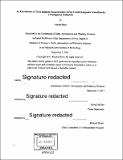| dc.contributor.advisor | David McGee. | en_US |
| dc.contributor.author | Brent, Kaylee | en_US |
| dc.contributor.other | Massachusetts Institute of Technology. Department of Earth, Atmospheric, and Planetary Sciences. | en_US |
| dc.coverage.spatial | f-mg--- | en_US |
| dc.date.accessioned | 2018-03-12T19:29:50Z | |
| dc.date.available | 2018-03-12T19:29:50Z | |
| dc.date.copyright | 2017 | en_US |
| dc.date.issued | 2017 | en_US |
| dc.identifier.uri | http://hdl.handle.net/1721.1/114099 | |
| dc.description | Thesis: S.B., Massachusetts Institute of Technology, Department of Earth, Atmospheric, and Planetary Sciences, 2017. | en_US |
| dc.description | Cataloged from PDF version of thesis. | en_US |
| dc.description | Includes bibliographical references (pages 21-23). | en_US |
| dc.description.abstract | Calcite and aragonite speleothems have been used for the past few decades to provide paleoclimate information, but in speleothems of mixed mineralogy the signal of mineral changes can complicate understanding of climate signals also present. This mineral signal must therefore be examined and controlled for. In this work, ICP-MS (inductively-coupled plasma mass spectrometry) analysis of trace element (strontium and magnesium) incorporation into calcium carbonate provides additional evidence for a shift in CaCO3 polymorphs identified via XRD (xray diffraction) analysis of speleothem AB-2 from Anjohibe Cave, Madgascar. The ICP-MS Sr/Ca data qualitatively supports the Sr/Ca data collected by the XRF core scanner, exhibiting a sharp decrease in value across the identified mineral transition. A corresponding increase in Mg/Ca revealed by the ICP-MS provides further evidence for a change from aragonite to calcite at this location. This mineralogical change occurred between 870-880 CE (+/- 13 years) is nearly concurrent with a shift in [delta]13C isotopes that was identified in previous work on this speleothem and attributed to an ecological shift in dominant photosynthetic pathways (Bums et al 2016). A second, control section was identified as pure calcite by XRD analysis, but revealed Mg/Ca and Sr/Ca ratios characteristic of mineralogical transitions, suggesting that there may have been layers of aragonite that have recrystallized to calcite since deposition. | en_US |
| dc.description.statementofresponsibility | by Kaylee Brent. | en_US |
| dc.format.extent | 25 pages | en_US |
| dc.language.iso | eng | en_US |
| dc.publisher | Massachusetts Institute of Technology | en_US |
| dc.rights | MIT theses are protected by copyright. They may be viewed, downloaded, or printed from this source but further reproduction or distribution in any format is prohibited without written permission. | en_US |
| dc.rights.uri | http://dspace.mit.edu/handle/1721.1/7582 | en_US |
| dc.subject | Earth, Atmospheric, and Planetary Sciences. | en_US |
| dc.title | An examination of trace element concentrations across calcite/aragonite transitions in a Madagascan stalagmite | en_US |
| dc.type | Thesis | en_US |
| dc.description.degree | S.B. | en_US |
| dc.contributor.department | Massachusetts Institute of Technology. Department of Earth, Atmospheric, and Planetary Sciences | |
| dc.identifier.oclc | 1027220799 | en_US |
